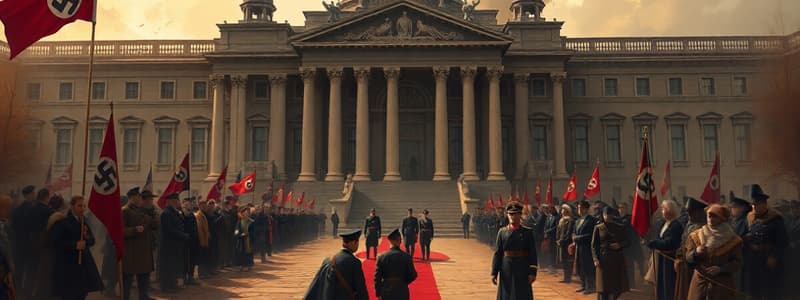Podcast
Questions and Answers
What was a primary consequence of the Treaty of Versailles after World War I?
What was a primary consequence of the Treaty of Versailles after World War I?
- Established lasting peace between European nations.
- Strengthened the democratic government in Germany.
- Promoted economic stability in Germany.
- Fostered a sense of resentment and desire for revenge in Germany. (correct)
The Molotov-Ribbentrop Pact of 1939 was an agreement between Germany and the Allied forces to divide Eastern Europe.
The Molotov-Ribbentrop Pact of 1939 was an agreement between Germany and the Allied forces to divide Eastern Europe.
False (B)
What event is generally considered to be the start of World War II in Europe?
What event is generally considered to be the start of World War II in Europe?
Germany's invasion of Poland
The German military strategy of rapid attacks, known as __________, resulted in quick victories over France, the Netherlands, and Belgium.
The German military strategy of rapid attacks, known as __________, resulted in quick victories over France, the Netherlands, and Belgium.
Which of the following events prompted the United States to enter World War II?
Which of the following events prompted the United States to enter World War II?
The Battle of El Alamein was a major victory for the Axis powers in North Africa.
The Battle of El Alamein was a major victory for the Axis powers in North Africa.
What was the significance of D-Day, which occurred on June 6, 1944?
What was the significance of D-Day, which occurred on June 6, 1944?
__________ refers to the systematic genocide of Jews and other groups by the Nazis during World War II.
__________ refers to the systematic genocide of Jews and other groups by the Nazis during World War II.
Match the following events with their corresponding dates:
Match the following events with their corresponding dates:
What international organization was formed in 1945 with the aim of preventing future wars?
What international organization was formed in 1945 with the aim of preventing future wars?
Flashcards
Versaillesfreden (1919)
Versaillesfreden (1919)
Tyskland fick hårda straff efter WW1, vilket skapade revanschlust.
Ekonomisk kris
Ekonomisk kris
Börskraschen 1929 ledde till fattigdom och gjorde diktaturer mer populära.
Nazism och Hitler
Nazism och Hitler
Adolf Hitler och nazistpartiet tog makten i Tyskland.
Molotov-Ribbentrop-pakten (1939)
Molotov-Ribbentrop-pakten (1939)
Signup and view all the flashcards
Tyskland anfaller Polen (1 sep 1939)
Tyskland anfaller Polen (1 sep 1939)
Signup and view all the flashcards
Blitzkrieg (1940-1941)
Blitzkrieg (1940-1941)
Signup and view all the flashcards
Operation Barbarossa (1941)
Operation Barbarossa (1941)
Signup and view all the flashcards
Pearl Harbor (7 dec 1941)
Pearl Harbor (7 dec 1941)
Signup and view all the flashcards
Förintelsen
Förintelsen
Signup and view all the flashcards
Nürnbergrättegångarna
Nürnbergrättegångarna
Signup and view all the flashcards
Study Notes
- The text is a concise guide about World War II.
Causes of World War II
- Treaty of Versailles (1919) imposed harsh penalties on Germany, fostering a desire for revenge.
- The 1929 stock market crash led to poverty, increasing the popularity of dictatorships.
- Adolf Hitler and the Nazi party seized power in Germany.
- Germany expanded aggressively without international intervention, while Britain and France tried to avoid war through appeasement.
- Molotov-Ribbentrop Pact (1939) involved Germany and the Soviet Union agreeing to divide Eastern Europe.
Key Events of World War II
- Germany invaded Poland on September 1, 1939, triggering declarations of war from Britain and France and marking the start of the war.
- Blitzkrieg (1940-1941) saw swift German victories over France, the Netherlands, and Belgium.
- During the Battle of Britain (1940), Germany and Britain engaged in an air war, which the British won.
- Operation Barbarossa (1941) was Germany's invasion of the Soviet Union.
- Pearl Harbor (December 7, 1941) led to Japan attacking the U.S. fleet, prompting the United States to enter the war.
- The Battle of Stalingrad (1942-43) marked a turning point on the Eastern Front, as Germany began to lose.
- The Battle of El Alamein (October-November 1942) was a major British victory in North Africa, turning the tide against the Axis powers.
- D-Day (June 6, 1944) involved the Allied landing in Normandy, leading to the liberation of France.
- Germany surrendered in May 1945 following Hitler's suicide, ending the war in Europe.
- Atomic bombs were dropped on Hiroshima and Nagasaki in August 1945, resulting in Japan's surrender and the end of the war.
- Swedish "Permittent Traffic" (1940–1943) allowed German soldiers to travel through Sweden, despite its neutrality.
Consequences of World War II
- The Holocaust was the Nazi genocide of six million Jews and other groups.
- The Nuremberg Trials exposed Nazi crimes, bringing some perpetrators to justice.
- The United States and the Soviet Union emerged as new superpowers.
- Germany and Europe were divided into West Germany (democracy) and East Germany (communism).
- The United Nations (UN) was formed in 1945 to prevent future wars.
- Israel was established in 1948 as a homeland for Jews following the Holocaust, sanctioned by a UN resolution.
Studying That Suits You
Use AI to generate personalized quizzes and flashcards to suit your learning preferences.




